ASRock Industrial 4X4 BOX-7840U mini-PC Review: AMD Phoenix in an UCFF Avatar
by Ganesh T S on December 28, 2023 8:30 AM ESTGPU Performance: Synthetic Benchmarks
AMD's Phoenix SoCs include an integrated GPU with a microarchitectural update over the one in the Rembrandt-R SoCs. The new RDNA3 microarchitecture is present in the Ryzen 7 7840U in the form of the Radeon 780M. With 12 CUs and 768 shader units clocked at 2.7 GHz, AMD claims that the GPU should be capable of playing virtually any modern game at Full HD resolutions. The slide below references the HS series, but the iGPU clock rates are the same for the U-series as well as the HS-series as per AMD's specifications. Obviously, the power budget dictates sustained performance numbers.
For full-blown desktop systems or mini-PCs targeting the gaming market, we look at gaming workloads. However, for general-purpose mini-PC models like the ASRock Industrial 4X4 BOX-7840U, we restrict ourselves to a series of canned benchmarks from Kishonti and Futuremark / UL. Prior to that, a look at the capabilities of the GPU via AIDA64 and GPU-Z is warranted.
Rembrandt-R's Radeon 680M had already achieved an industry-first by integrating hardware-accelerated ray tracing, and the Radeon 780M in Phoenix builds upon that. There are some improvements in the media engine too (such as AV1 encode support), but those are not revealed in the GPU-Z screenshot. The remaining subsections below look into the performance aspects.
GFXBench
The DirectX 12-based GFXBench tests from Kishonti are cross-platform, and available all the way down to smartphones. As such, they are not very taxing for discrete GPUs and modern integrated GPUs. We processed the offscreen versions of the 'Aztec Ruins' benchmark.

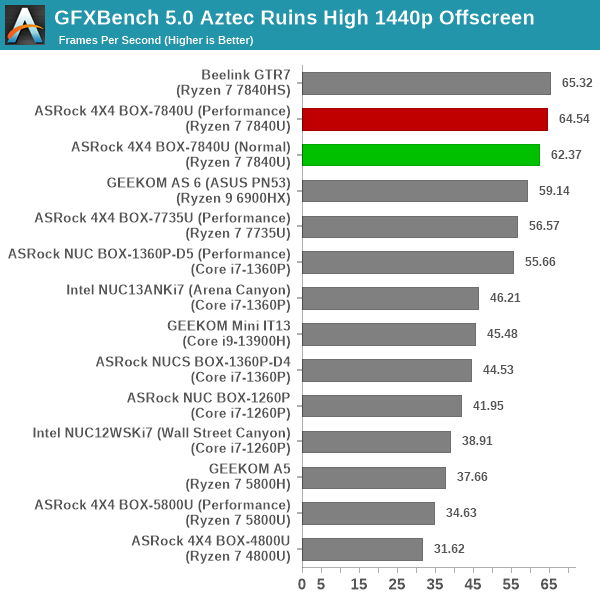
At 1080p, the Core i7-1360P with a 40W power budget slightly outscores the Phoenix-based systems (including the 65W GTR7). However, at 1440p, the AMD RDNA2 and RDNA3 systems have a clean break-out and move to the top of the pack.
UL 3DMark
Four different workload sets were processed in 3DMark - Fire Strike, Time Spy, Night Raid, and Wild Life.
3DMark Fire Strike
The Fire Strike benchmark has three workloads. The base version is meant for high-performance gaming PCs. It uses DirectX 11 (feature level 11) to render frames at 1920 x 1080. The Extreme version targets 1440p gaming requirements, while the Ultra version targets 4K gaming system, and renders at 3840 x 2160. The graph below presents the overall score for the Fire Strike Extreme and Fire Strike Ultra benchmark across all the systems that are being compared.
| UL 3DMark - Fire Strike Workloads | |||
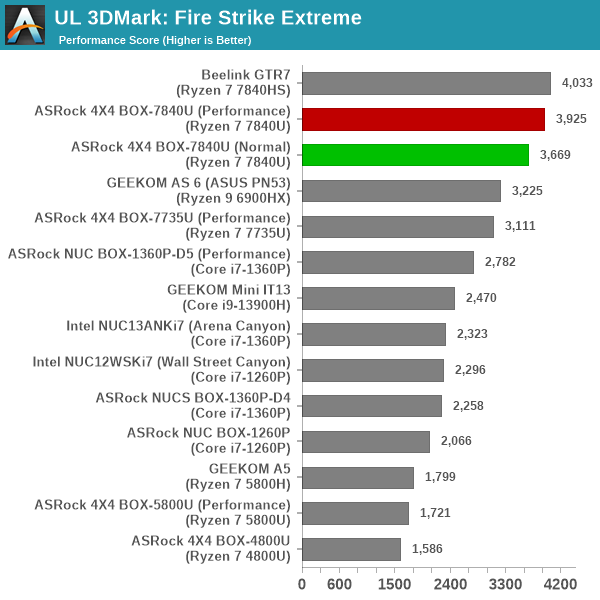
The lead for the RDNA2 iGPU over RPL-P's Iris Xe was already evident in previous reviews, and we see that Phoenix cements this position further - with a bigger lead as the power budget is increased.
3DMark Time Spy
The Time Spy workload has two levels with different complexities. Both use DirectX 12 (feature level 11). However, the plain version targets high-performance gaming PCs with a 2560 x 1440 render resolution, while the Extreme version renders at 3840 x 2160 resolution. The graphs below present both numbers for all the systems that are being compared in this review.
| UL 3DMark - Time Spy Workloads | |||
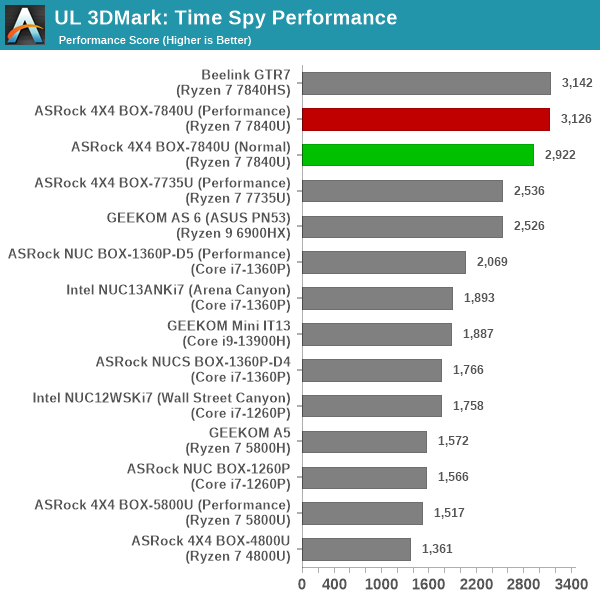
The observations made in the Fire Strike workloads hold true here also. However, we can note that the benefit of increasing the available power budget from 40W to 65W is not as significant as what is obtained in moving from 28W to 40W. This indicates that the 65W configuration is beyond its operating sweet spot.
3DMark Wild Life
The Wild Life workload was initially introduced as a cross-platform GPU benchmark in 2020. It renders at a 2560 x 1440 resolution using Vulkan 1.1 APIs on Windows. It is a relatively short-running test, reflective of mobile GPU usage. In mid-2021, UL released the Wild Life Extreme workload that was a more demanding version that renders at 3840 x 2160 and runs for a much longer duration reflective of typical desktop gaming usage.
| UL 3DMark - Wild Life Workloads | |||
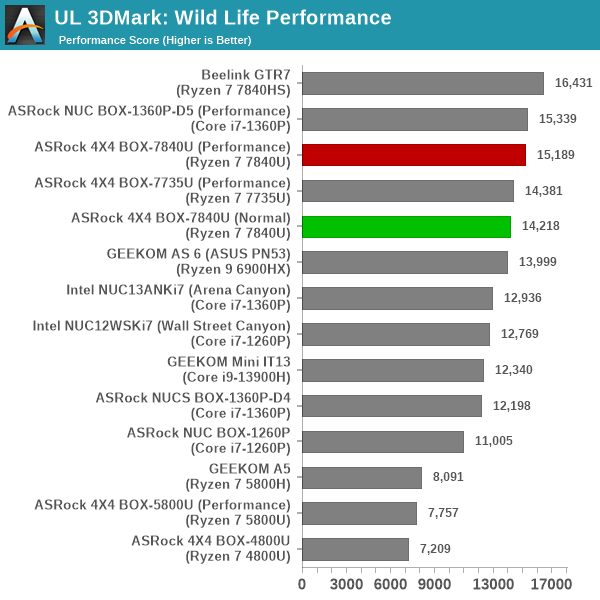
At 1440p, the Iris Xe iGPU in RPL-P puts up a creditable performance and almost matches the Radeon 780M performance, but 4K leaves that well behind, as the Phoenix configurations take up the top three spots with a significant lead.
3DMark Night Raid
The Night Raid workload is a DirectX 12 benchmark test. It is less demanding than Time Spy, and is optimized for integrated graphics. The graph below presents the overall score in this workload for different system configurations.

The Radeon 680M and 780M configurations have a clear lead over the Iris Xe iGPU in RPL-P and the lead only grows with the available power budget for the AMD processor package.
3DMark Port Royal
UL introduced the Port Royal ray-tracing benchmark as a DLC for 3DMark in early 2019. The scores serve as an indicator of how the system handles ray-tracing effects in real-time.
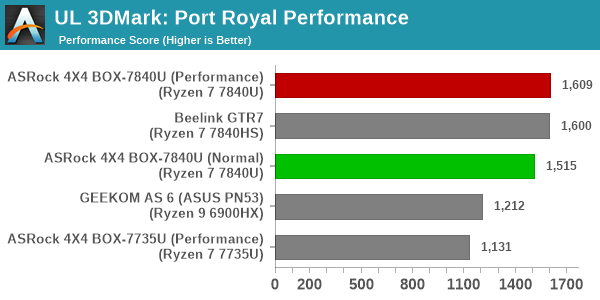
Ray tracing performance has improved in moving from Radeon 680M to 780M, as expected from a new generation. Interestingly, there doesn't seem to be much benefit to power budgets beyond 40W for this workload.


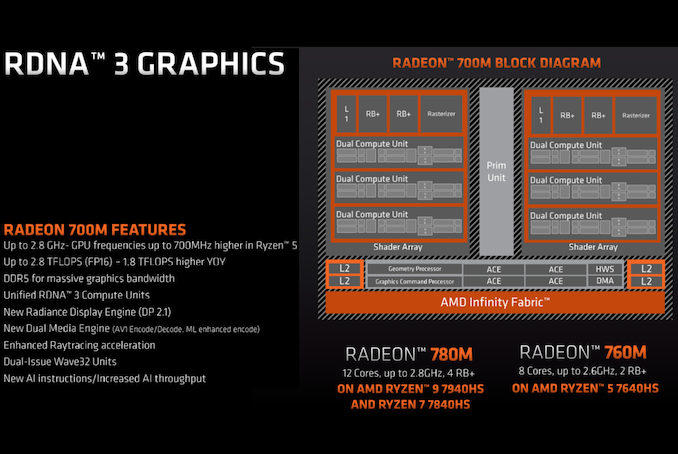









13 Comments
View All Comments
ingwe - Thursday, December 28, 2023 - link
Can the system be powered via one of the USB4 ports? I didn't see that noted but would much prefer that option. Particularly with the size of the power brick.meacupla - Thursday, December 28, 2023 - link
I doubt it. They have "USB/DP" labelled, but the lack of "/PD" is a sign that it most likely does not.TheinsanegamerN - Tuesday, January 2, 2024 - link
No, its wired to use the power brick for power input.kenyee - Thursday, December 28, 2023 - link
They should have made both Ethernet ports 2.5GB.Nice design otherwise....
meacupla - Thursday, December 28, 2023 - link
I'm kind of curious to know why they include a 120W power adapter when it only consumes 74W at full load.Do the 5x USB ports support 10W output each or something?
PeachNCream - Friday, December 29, 2023 - link
In this case 120W as a worst-case scenario with a bit of wiggle room seems reasonable especially when compared to nerds that routinely vastly overestimate their power supply needs and stuff a irrationally overspec PSU into the dinosaur-obsolete desktop form factor gaming/streaming/"esports" case.TheinsanegamerN - Tuesday, January 2, 2024 - link
USB 3 supports .9 amp per port, so 2.7 total, plus 1 for the 2 on the back. 3.7x5 is 18.5. 92.5 overall.Most off the shelf supplies are either 90, 120, or 135. So a 120 it is then. This also gives you headroom for capacitor aging and heat related power draw.
mode_13h - Thursday, December 28, 2023 - link
I don't see how they can pitch it as an industrial PC without ECC support (which I assume it lacks, since it wasn't mentioned).As a generic mini-PC, it does look like a good option, both in terms of multithreaded performance and efficiency. Too bad they didn't manage to close the gap with Intel's Raptor Lake-P NUCs, on idle power.
PeachNCream - Friday, December 29, 2023 - link
They're probably just using that in marketing materials so that retail/home buyers feel like they're getting something more reliable because its supposedly designed for industry usage. It's similar to how companies proclaim something is "off-road" to sell something to someone that might drive through their neighbor's yard or hit a curb at the grocery store. Also, if everyone does it, you can't be the vendor left out or people will ask, "Why does such-and-such not have a Sport Utility Vehicle Super Sport model? The word sport should be in the name or its not as good!"charlesg - Friday, December 29, 2023 - link
I agree with Peaches.It's basically marketing, which is mostly, um, using appealing terms, true or not.